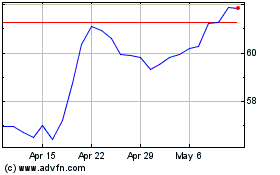Big Banks Find Sweet Spot in Higher Rates
January 15 2019 - 3:39PM
Dow Jones News
By Peter Rudegeair and Emily Glazer
The honeymoon period for big banks when it comes to higher
interest rates is stretching out longer and longer.
The Federal Reserve's decision to raise its benchmark short-term
rate four times in 2018 helped lift revenue at JPMorgan Chase &
Co. and Wells Fargo & Co. during the last three months of the
year. The cost to borrow on credit cards and other types of loans
without fixed interest rates is tied to the Fed actions, allowing
banks to pocket higher interest payments on those loans.
The higher rates have yet to sting banks' bottom lines. They
have been able to hold off on raising rates too much on deposits to
prevent customers from seeking better returns elsewhere.
Markets have been on edge in recent weeks after investors
revised their outlook around global economic growth, the pace of
future Fed rate increases and the effect of the partial U.S.
government shutdown on the economy. That change in sentiment has
weighed on bank stocks: over the past three months, the KBW Nasdaq
Bank Index is down about 8%, more than the decline in the S&P
500 index in that same span.
But bank executives said on Tuesday that despite the market
turbulence, underlying business performance and economic trends
remain favorable.
"There's nothing we see in the data... that suggests the economy
is rolling over or a recession is imminent," said Jason Ware, chief
investment officer of Albion Financial Group, which owns around
137,000 shares in JPMorgan. "That's underpinned by a healthy
consumer, still-low interest rates, rising confidence and a healthy
jobs market."
Net interest income at JPMorgan, the amount it earns from loans
and securities minus the amount it pays to depositors and
creditors, rose 10% in the fourth quarter to $14.4 billion. That
helped push overall net income up by two-thirds to $7.07 billion.
Wells Fargo enjoyed a 3% boost to net interest income, but profit
fell 1.4% to $6.06 billion due to weak consumer results, especially
in its all-important mortgage business.
Improved lending revenues helped offset an end-of-year slowdown
in banks' trading businesses, where bouts of volatility prompted
many Wall Street clients to step back from the markets and sapped
one of banks' biggest sources of fees. A tepid period of new bond
issuance helped keep investment-banking fees stagnant from a year
earlier.
Banks' consumer units were the biggest beneficiaries of higher
lending income. JPMorgan profit in that unit was $4.03 billion in
the fourth quarter, up 53% from $2.63 billion in the year-earlier
period, driven largely by better margins and an increase in
credit-card balances. At Citigroup Inc., which reported earnings on
Monday, net interest revenue from the bank's U.S. branded-card
business rose 6% from a year ago to $2 billion in the fourth
quarter.
Meanwhile, the rates banks paid out on deposits, while rising,
lagged behind the uptick in loan yields. At JPMorgan, the average
interest rate on its loan book in the fourth quarter rose 0.59
percentage points to 5.26% while the average rate on its
interest-bearing deposits increased 0.37 percentage points to
0.72%.
There was weakness in mortgage lending, where rate increases are
felt most acutely as borrowers refrain from refinancing their home
loans when interest costs rise. JPMorgan said that mortgage volume
fell 30% in the fourth quarter, which contributed to mortgage
revenue declining 8% in $1.32 billion. Wells Fargo's mortgage
volume fell by a similar percentage in the fourth quarter after
refinancing activity fell by more than 50%.
Smaller banks also reported similar results. Shares of First
Republic Bank were on track to climb by the largest percentage
increase on record, according to Dow Jones Market Data, after the
bank reported earnings and net interest income that beat analysts'
estimates. The bank also reported a net interest margin, which
measures how profitably it can lend out depositors' funds, that was
higher than its own expected range.
A number of factors could alter the trajectory for the U.S.
economy and interest rates. Investors are betting that there is a
high chance that the Fed either keeps rates stagnant or cuts them
by the end of the year. And JPMorgan CEO James Dimon said on a
conference call with reporters that if the government shutdown
lasted through the first three months of 2019, that could send U.S.
economic growth to zero.
Mr. Dimon urged analysts to look at the underlying reasons
behind any interest-rate move to determine how it would affect big
banks.
"The why is equally if not more important than the what," said
Mr. Dimon. "If it is a pause because you are going to go to
recession [and] you're going to reduced rates, that obviously is
very different than it's a pause, economy strong and they raise
rates."
--Telis Demos and Allison Prang contributed to this article.
Write to Peter Rudegeair at Peter.Rudegeair@wsj.com and Emily
Glazer at emily.glazer@wsj.com
(END) Dow Jones Newswires
January 15, 2019 15:24 ET (20:24 GMT)
Copyright (c) 2019 Dow Jones & Company, Inc.
Wells Fargo (NYSE:WFC)
Historical Stock Chart
From Aug 2024 to Sep 2024

Wells Fargo (NYSE:WFC)
Historical Stock Chart
From Sep 2023 to Sep 2024
